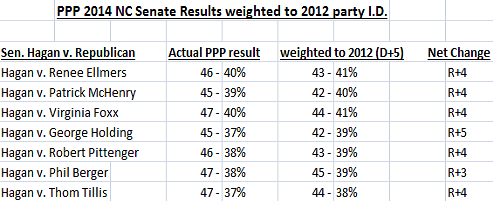From left, Homeland Security Head Janet Napolitano, outgoing, one-term North Carolina Governor Beverly Perdue (D), and 2014 Senate candidate for North Carolina, incumbent Senator Kay Hagan (D) in 2011. (AP Photo/The News & Observer, Chris Seward) (Credit: AP)
Public Policy Polling's survey of their home state, the first of the new year, delivered somewhat of a split verdict for Democrats and Republicans of North Carolina. On the bright side for Republicans, their newly elected Governor Pat McCrory is starting his term with largely positive feelings from most voters, sporting a 45% job approval rating, with just 19% disapproving. At the same stage of ex-Gov. Beverly Perdue's governorship in 2009, her job approval rating was at a much lower 43/32%. Not only is McCrory the most popular politician in the state, but President Obama, who currently averages a national job approval rating of 52/43%, is underwater at 46/52%. Tom Jensen of PPP notes in the release:
According to the 2009 poll, President Obama held an approval rating of 52% and aDemocrat Kay Hagan remains largely unknown and hardly-liked after 4 years as Senator, with a job approval/disapproval rating of 34/36%.
disapproval rating of 41%. In this current poll, Obama holds a 46% approval rating and
52% disapproval rating. This change in approval rating is reflected in the change from
North Carolina going blue in the 2008 election to red in the 2012 election.
The one bright-spot for Democrats in North Carolina is the fact that at this early stage of the 2014 cycle, there appears to be no credible Republican challenger to Sen. Hagan's seat in Washington. Despite her apparent middling poll numbers, all 7 potential Republican challengers tested by PPP failed to get closer than 6 points to the U.S. Senator who 31% of her constituents have no opinion of. Two possible GOP candidates tie for coming the closest to Sen. Hagan: Rep. Renee Ellmers (R), a 2-term Congresswoman from the 2nd district trails just 46-40%, and Rep. Patrick McHenry (R), a 5-term Congressman from the 10th district trails 45-39%. Hagan's weakest opponent, NC State Representative Thom Tillis trails by 10 points, 47-37%.
One thing worth noting, especially considering the typically older, whiter midterm electorates, is that PPP found NC voters identifying as 12 points MORE Democratic than Republican in their 2014 poll. Unfortunately, no exit polls were conducted during the last midterm election in NC (2010), and exit polling is unavailable for NC's 2002 midterm election. But it is worth pointing out that in the 2012 Governor's race between Pat McCrory (R) & Walter Dalton (D) just 2.5 months ago, Democrats only held a five point advantage over the Republicans in partisan identification. Even more telling than that, NC party I.D. was only D+11 in the 2008 Governor's race, the same year that a Democrat won NC on the presidential level for the first time since 1976. So while PPP's party ID finding may be a reflection of current dissatisfaction with Republicans in Washington, it also reflects a more Democratic electorate than North Carolina has seen in recent history, especially for a midterm election. Below are tables explaining what Barack Obama's, Pat McCrory's (R), and Kay Hagan's (D) job approval numbers would have looked like had PPP found NC party ID the same as the 2012 Governor's race (38% Democrat, 33% Republican, 28% Independent, or D+5), all other findings remaining the same:
As you can see, naturally, the numbers decline for Democrats as their numbers in the electorate decline. For example, Barack Obama's 46/52% job approval/disapproval rating becomes 44/55% when shifting PPP's party I.D. from D+12 to D+5. For the record, the shift in party ID has less disastrous consequences for Sen. Kay Hagan when matched against her likely GOP opponents. Even when reweighting the PPP poll from D+12 to 2012's Governor turnout, Hagan's closest competitor still trails by 2 points, 43-41%:
The primary reason Hagan remains so resilient in the face of shifting partisan ID's is the fact that she leads each one of her possible GOP opponents among Independent voters by as much as 13 points and as little as 3 points. Though still, as the last column on the above chart notes, the move from D+12 to D+5 shifts each hypothetical 2014 race no less than 3 points towards the GOP, and as much as 5 points.
Kay Hagan's folks may think being 6-10 points ahead of her competitors this far out is great news. But when the closest you ever get to a majority of the vote is 47%, the President from your party is underwater in your home state, and the partisan sample of the poll you're relying on is D+12...you shouldn't get too confident.






No comments:
Post a Comment
Note: Only a member of this blog may post a comment.